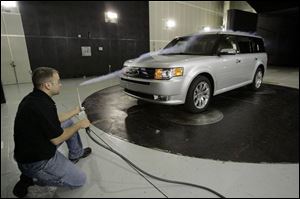
Automakers declare war on wind noise
6/19/2008
A spout from a smoke wand tracks the aerodynamics of a preproduction Flex at Ford's test facility in Allen Park, Mich.
ALLEN PARK, Mich. - As an 80 mile per hour wind blew over a preproduction model of the Ford Flex, Steve Dworack heard a buzz.
Mr. Dworack, the vehicle's wind noise engineer, tracked the buzz to a vertical trim piece between the windshield and the pillar that holds up the roof.
The part was replaced with a stiffer one, at a cost of $10,000, just two months before the factory was to start cranking out Flexes by the thousands.
Ford Motor Co. willingly shouldered the expense. Wind noise is the No. 1 consumer complaint in the closely watched J.D. Power and Associates initial quality survey.
"We basically do whatever it takes to find a solution," Mr. Dworack said during a recent wind tunnel test at a facility that Ford leases in Allen Park, near Detroit.
Engineers are spending thousands of hours inside wind tunnels, using computers, microphones, and their ears to rid vehicles of as much clatter as possible.
"No one can afford to get left behind," said Dave Sargent, vice president of automotive research for J.D. Power. "If you get a reputation for having very noisy cars, then the natural consequence is people stop buying."
Said Mark Gleason, Chrysler LLC's supervisor of aerodynamics, "Anytime you have something generating a noise, what you've got is energy being consumed. And energy consumed is fuel consumption."
At Honda Motor Co., engineers spent hours perfecting the redesigned 2008 Accord's side-view mirrors to keep them quiet yet retain their ability to fold if they hit something.
Other automakers have abandoned folding mirrors, but Honda customers have demanded them, said Clement D'Souza, the car's associate chief engineer in Marysville, Ohio.
Honda has used wind tunnel tests over the years to focus on gaps between moving mechanisms such as mirrors and doors.
The testing has helped it reduce wind noise complaints in the J.D. Power study from around 12 problems per 100 vehicles on the 1998 Accord to one or two in the newest model, Mr. D'Souza said.
On the Ford Flex, which has 220 pieces of sheet metal, designers and engineers have worked to tighten seams.
If a car has a lot of wind noise, the problem is likely to be with the basic design, and it can't be fixed later on, Mr. Sargent said.
Said Chrysler's Mr. Gleason, "We're advancing the degree of application very rapidly on all our vehicles. We don't really have a lot of choice."